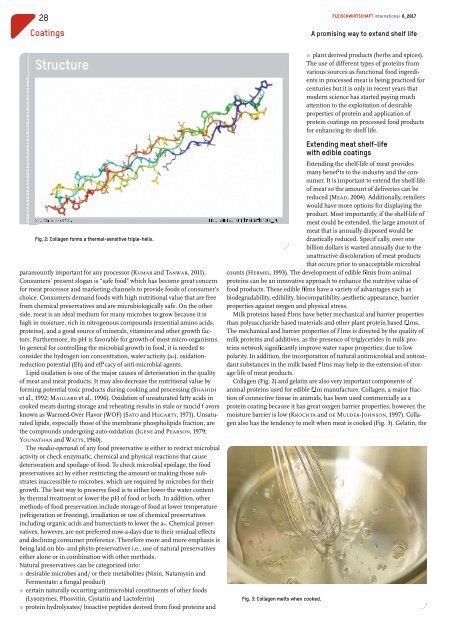FLEISCHWIRTSCHAFT international 6/2017
You also want an ePaper? Increase the reach of your titles
YUMPU automatically turns print PDFs into web optimized ePapers that Google loves.
............................................<br />
28<br />
Fleischwirtschaft <strong>international</strong> 6_<strong>2017</strong><br />
Coatings<br />
Apromising way to extend shelf life<br />
Source: KUMAR et al. <strong>FLEISCHWIRTSCHAFT</strong> <strong>international</strong> 6_<strong>2017</strong><br />
Fig. 2: Collagen forms athermal-sensitive triple-helix.<br />
paramountly important for any processor (KUMAR andTANWAR,2011).<br />
Consumers’ present slogan is “safe food”which has become great concern<br />
for meat processor and marketing channels to provide foods of consumer’s<br />
choice. Consumers demand foods with high nutritional value that are free<br />
from chemical preservatives and are microbiologically safe. On the other<br />
side, meat is an ideal medium for many microbes to grow because it is<br />
high in moisture, rich in nitrogenous compounds (essential amino acids,<br />
proteins), and agood source of minerals, vitamins and other growth factors.<br />
Furthermore, its pH is favorable for growth of most micro-organisms.<br />
In general for controlling the microbial growth in food, it is needed to<br />
consider the hydrogen ion concentration, water activity (aw), oxidationreduction<br />
potential (Eh) and effif cacy of anti-microbial agents.<br />
Lipid oxidation is one of the major causes of deterioration in the quality<br />
of meat and meat products. It may also decrease the nutritional value by<br />
forming potential toxic products during cooking and processing (SHAHIDI<br />
et al., 1992; MAILLARD et al., 1996). Oxidation of unsaturated fatty acids in<br />
cooked meats during storage and reheating results in stale or rancid fl<br />
avors<br />
known as Warmed-Over Flavor (WOF) (SATO and HEGARTY,1971).Unsaturated<br />
lipids, especially those of the membrane phospholipids fraction, are<br />
the compounds undergoing auto-oxidation (IGENE and PEARSON,1979;<br />
YOUNATHAN and WATTS,1960).<br />
The modus-operandi of any food preservative is either to restrict microbial<br />
activity or check enzymatic, chemical and physical reactions that cause<br />
deterioration and spoilage of food. To check microbial spoilage, the food<br />
preservatives act by either restricting the amount or making those substrates<br />
inaccessible to microbes, which are required by microbes for their<br />
growth. The best way to preserve food is to either lower the water content<br />
by thermal treatment or lower the pH of food or both. In addition, other<br />
methods of food preservation include storage of food at lower temperature<br />
(refrigeration or freezing), irradiation or use of chemical preservatives<br />
including organic acids and humectants to lower the aw.Chemical preservatives,<br />
however,are not preferred now-a-days due to their residual effects<br />
and declining consumer preference. Therefore more and more emphasis is<br />
being laid on bio- and phyto-preservatives i.e., use of natural preservatives<br />
either alone or in combination with other methods.<br />
Natural preservatives can be categorized into:<br />
r desirable microbes and/ or their metabolites (Nisin, Natamysin and<br />
Fermentate: afungal product)<br />
r certain naturally occurring antimicrobial constituents of other foods<br />
(Lysozymes, Phosvitin, Cystatin and Lactoferrin)<br />
r protein hydrolysates/ bioactive peptides derived from food proteins and<br />
r plant derived products (herbs and spices).<br />
The use of different types of proteins from<br />
various sources as functional food ingredients<br />
in processed meat is being practiced for<br />
centuries but it is only in recent years that<br />
modern science has started paying much<br />
attention to the exploitation of desirable<br />
properties of protein and application of<br />
protein coatings on processed food products<br />
for enhancing its shelf life.<br />
Extending meat shelf-life<br />
with edible coatings<br />
Extending the shelf-life of meat provides<br />
many benefi<br />
ts to the industry and the consumer.Itisimportant<br />
to extend the shelf-life<br />
of meat so the amount of deliveries can be<br />
reduced (MEAD,2004). Additionally,retailers<br />
would have more options for displaying the<br />
product. Most importantly,ifthe shelf-life of<br />
meat could be extended, the large amount of<br />
meat that is annually disposed would be<br />
drastically reduced. Specifi<br />
cally,over one<br />
billion dollars is wasted annually due to the<br />
unattractive discoloration of meat products<br />
that occurs prior to unacceptable microbial<br />
counts (HERMEL,1993). The development of edible fi<br />
lms from animal<br />
proteins can be an innovative approach to enhance the nutritive value of<br />
food products. These edible films have avariety of advantages such as<br />
biodegradability,edibility,biocompatibility,aesthetic appearance, barrier<br />
properties against oxygen and physical stress.<br />
Milk proteins based fi<br />
lms have better mechanical and barrier properties<br />
than polysaccharide based materials and other plant protein based films.<br />
The mechanical and barrier properties of fi<br />
lms is directed by the quality of<br />
milk proteins and additives, as the presence of triglycerides in milk proteins<br />
network signifi<br />
cantly improve water vapor properties, due to low<br />
polarity.Inaddition, the incorporation of natural antimicrobial and antioxidant<br />
substances in the milk based fi<br />
lms may help in the extension of storage<br />
life of meat products.<br />
Collagen (Fig. 2) and gelatin are also very important components of<br />
animal proteins used for edible fi<br />
lm manufacture. Collagen, amajor fraction<br />
of connective tissue in animals, has been used commercially as a<br />
protein coating because it has great oxygen barrier properties, however,the<br />
moisture barrier is low (KROCHTA and DE MULDER-JOHNSON,1997). Collagen<br />
also has the tendency to melt when meat is cooked (Fig. 3). Gelatin, the<br />
Fig. 3: Collagen melts when cooked.

















